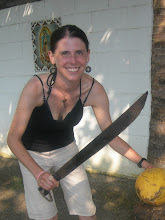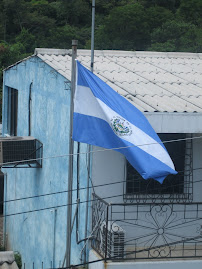

Just a few weeks ago, a group of 27 adults and 5 kids from the Asociacion de Desarrollo Comunal Indigena Nahuat (ADESCOIN) took a 4-hour trip to a small canton at the Honduran border called Santa Marta. We were invited there by an NGO called Asociacion de Desarrollo Economico Social (ADES), which had sent two groups to visit us in Santo Domingo de Guzman. They came to learn about the indigenous culture and the history of our town and so they invited us to learn about the history of and activities going on in their town. It was the first time that many of the people from Santo Domingo had ever been to that area of El Salvador, so what a great opportunity for them to know more about their own country.
When we arrived, a group of people met us at the local school and took us on a brief tour of the town. We got to see their green-house project, which allows them to grow veggies even during the dry season. When it does rain, they use a rainwater irrigation system and also have an organic fertilizer project. While it is funded by a foreign NGO, all of the employees are from Santa Marta and some are even getting educated in engineering so that they can head the project, making it more sustainable. It was great to see them so organized; hopefully their experience will be an inspiration for us!
After the tour, a couple of women told us about the history of the town, specifically during the recent Civil War and even sang some songs they had written to memorialize their suffering. They had a tragic experience of the armed forces invading their town in the late 1970s, suspicious of people organizing against the government. They would enter peoples homes, take out the men and torture, disappear, or kill them and then rape the women and young girls. They would take the babies and throw them in the air and spear them. They would then sometimes set the homes on fire, even with people inside. At the start of the 80s, the people of Santa Marta could not take it anymore and fled into Honduras. As they were crossing the Rio Lempa, hundreds were killed, either by the strong current, by helicopters firing at them, or by the Honduran army firing at them from the other side of the river. Those who made it safely, eventually made it to a refugee camp where they lived for several years before returning to repopulate Santa Marta. I was left speechless, trying to imagine what it must have been like going through that since I have never seen war firsthand. The people from Santo Domingo, however, recounted that they had a similar history of soldiers coming into their homes and taking out the men, killing them right there or disappearing them. And it was people from within town that ratted people out, giving out names to the army of men they accused of being guerillas, even if they weren't. Because of this, men had to spend nights in a cave nearby for many years of the war and to this day there is some division in town, due to the fact that some of those who were accusers are still alive. How do you even begin a real reconciliation when this tragic past is still so fresh?
At the end of the trip, we visited a community radio nearby, called Radio Victoria. It was great to hear about the work of this radio to offer a space for people in the surrounding area to debate issues, state the needs of their communities, etc... They get to express their voice in a country with a mass communications system that is more dedicated to consumerism and the needs of the wealthy. They radio team even invited us to make an announcement on air, so Don Margarito said a greeting in Nahuat and then of course translated it into Spanish.
While it was a long day, with more hours spent in transport than in location, I felt blessed to be a part of this interchange of pueblos.








